|
|
| |
| 1931 Bentley 4½ Litre Supercharged |
|
|
Original 1931 Numbers
Chassis No. MS3926
Engine No. MS3929
Registration No. GO 1400
|
|
This car - updated
Chassis No. MS3926
Engine No. -
Registration No. GO 1400
(Updated with information from owner Frederick A Simeone. - May 2018) |
|
| |
|
|
 |
| |
"Greetings Robert,
Just today I received a note from
someone who tracked down the original
owner of my Blower Bentley.
He was T.G. Moore who had just purchased
Motorsport Magazine.
A Bugatti friend, Mark Morris found
his son and the correspondence below
was sent a few minutes ago as he promises
to send along copies of whatever info
survives. If it is of interest I shall pass
it on to you.
Thank you for acknowledging my small
contribution to you stories" |
|
| |
|
|
| |
|
|
| |
Source:
Fred Simeone - Simeone Museum
Posted: Apr 09, 2015 |
|
| |
|
|
| |
From:
Fred Simeone
Sent: Wednesday, April 08, 2015
To: Alex Moore
Subject: Blower Bentley
Greetings Mr. Moore,
I have long searched the provenance
of our 1930 Supercharged 4.5 litre
Bentley 3926. It now resides proudly
in our museum and you can get a glimpse
at www.simeonemuseum.org
I wanted an original bodied Blower
and even back then they were are to
find, the majority of survivors converted
to boy racers with the Golden Era
still in memory.
A GI found your car in a place called
Aylesbury [spelling?] and put in on
a boat back to the States intending
to do a restoration that never happened.
We found it easy to revive as all
the pieces were there and in good
shape.
The records show your dad ordered
it with certain specials: e.g. fully
valenced fenders and frame rail covers
[louvered now]; running board lowered,
collinear with the hub centers; doors
extending to the frame rail in contrast
vandenPlas’ usual sporting cars
that had those short, rudimentary
doors.
I always thought the last two modifications
were to avoid the necessity to hike
up one’s skirt [perhaps your
mum] on entering the rear seats.
Anyway they all survive.
T.G. took the car out to a Manx timed
trial and won at 62.33 MPH. This is
duly recorded in his recently acquired
Motorsport magazine, April, 1933,
page 383.
So you see I am involved, and I would
appreciate any scraps of information,
pictures or whatever to add to our
dossier on this, one of our favorites.
Should find yourself in the States
you are always welcome. You will find
she still drives powerfully!
Fred |
|
| |
|
|
|
|
 |
 |
| |
"About MS3926;
car was ordered by TG Moore who at
the time was publisher of the Motorsport
Magazine. He ordered specifically
from VDP with a "fully valenced
aluminum body" with the doors
coming down to the frame rail, and
the running boards in line with the
wheel centers. This apparently was
to relieve someone, probably a young
lady, from the embarrassment of having
to climb over those small doors so
typical for the sporting VDP cars.
When discovered, the car had all of
the features listed in the factory
records and the body maker’s
report.
We received it as a complete car with
the body intact although the rear
portion had to be repaired. The wood
on the running board was also replaced.
When we received it, it had a non-original
folding windscreen, which had obviously
been on the car for a long time, since
we have pictures of it in England
just after the War with a folding
windscreen. We did what I call a mixed
restoration. Since we are not chasing
trophies at shows, everything that
could be kept in original condition
was preserved. Nothing was shined.
The original dashboard wood —
with an extra hole was kept. Consequently,
under the hood, it does not look real
fresh. On the other hand, it did require
paint and upholstery and this was
done to the original colors as best
we can determine. We did replace the
headlamps with the correct style.
A small repair was done on the corner
of the supercharger cover before it
was painted. Consequently have believe
it is one of the most original supercharged
Bentleys around, although it does
not compare with at least one on your
list which is totally preserved and
in absolutely wonderful condition.
I can send more pictures if you are
interested." |
|
| |
|
|
| |
|
|
| |
Source:
Fred Simeone - Simeone Museum
Posted: Apr 02, 2013 |
|
| |
|
|
| |
Dr.
Frederick A. Simeone has established
a foundation to preserve and display
54 selected cars built 1909 and 1975.
Opened in 2008, the Simeone Foundation
Automotive Museum was recently voted
"Museum of the Year" by
the International Historic Motoring
Awards at the ceremony in London.
The museum is located in Philadelphia,
Pennsylvania and the web site is www.SimeoneMuseum.org
|
|
| |
|
|
|
|
 |
| Click
on thumbnail for larger view |
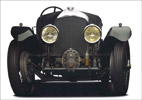 |
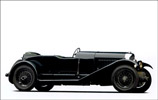 |
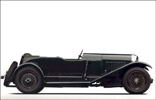 |
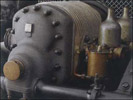 |
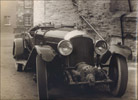 |
|
|
| |
 |
| |
The history of
Supercharger MS3926 and more
The history of great racing Bentleys
is well known. From 1927 to 1930,
they were unbeatable in endurance
racing, having won Le Mans during
those four years with, first, a 3-liter,
then a 4½-liter, and finally,
the Speed 6 in 1929 and 1930. In an
effort to get even more horsepower
from the great 4-cylinder 4½-liter
car, supercharging was suggested,
as already used successfully by Bugatti,
Alfa Romeo and others. There is an
oft repeated story that W.O. Bentley
himself opposed this method of getting
additional power. He favored increasing
engine size. The story goes that it
was Sir Henry Birkin, sponsored by
the Honorable Dorothy Paget, to whom
Mr. Bentley finally relented and made
the 50 obligatory cars for sale to
the public, as well as five special
racing type cars.
The supercharger operates on Rootes
principles, with two synchronized
twin lobe rotors. The boost given
was 10 psi at 25 miles per hour in
top gear and does not exceed 11 psi
at the highest engine speeds. With
this engine and a light single-seater
body, the car established the Brooklands
Outer Circuit Record at 137.9 miles
per hour. These cars were impressive
in their power and speed, but were
not yare and therefore unsuccessful
racing cars. Even in local British
Racing Drivers Club competition, they
usually retired in the 500 mile race
with one noteworthy second place finish
in 1930. Because a supercharged Bentley
traveled the fastest on the Brooklands
banked circuit, the "Blower"
will forever be a symbol of powerful
British motoring. Its pyknic image
in Rexene-clothed, cycle-fender, bells-and-whistled
armor, with the ponderous blower menacing
fore is an icon of the manly British
bolide.
Serial Number: MS3926
This car was ordered by T.G. Moore
and it was registered in 1931, donned
in a Vanden Plas-built special aluminum
tourer body. Specified on the original
build sheet are the design features
that are still on the car. The doors
were to come down to the frame rails,
not the skimpy doors so commonly seen
on Vanden Plas bodies. The running
boards were to be in line with the
center of the wheel hubs. The body
was to be fully valanced, which means
the front fenders extended all the
way down to the chassis and, in addition,
the frame rails were louver-covered
from front fender to rear fender.
The body was to be painted Le Mans
Green with the matching upholstery
and a dark walnut dashboard.
T.G. Moore, who had just acquired
Motor Sport as its publisher, must
have been very proud of his new car.
It is likely that he took it to a
variety of events, but the most notable
one was outlined in page 383 of Motor
Sport, April 1931. He won the timed
trial of the Isle of Man with a speed
of 62.33 miles per hour, which was
significantly better than the competitors.
This proud showing was probably repeated
because, ultimately, the car was re-registered
in the Isle of Man while still under
Moore's ownership. Subsequently, it
went through several hands and it
was discovered after the war in Aylesbury
by U.S. serviceman Robert K. Carter
who shipped it to the United States.
Mr. Carter had every intention of
restoring the car, but as time went
on, it became obvious that this was
not happening.
We were looking for that nearly extinct
beast, a Blower with its original
body; the majority of the survivors
were by then re-invented as boy racers.
We bought her from Mr. Carter in 1981
and started a restoration. The car
was in remarkably preserved condition
though it did not have top bows, (nor
does it have them now). Other than
that, nothing was seriously missing.
The rear end had been cut back a bit,
but this was easily restored. Beyond
this, all external metal was original.
There were no missing instruments.
The original engine and the D-type
gearbox were intact and really did
not require much internal fettling,
although they were refreshed. The
sump had to have repairs because oil
had been laying in it for decades
and this ate through the metal in
some spots.
The mechanical work was done by Jim
McHenry of the Ball and Ball Shop
in West Chester, Pennsylvania. Jim
and I had an excellent working relationship
and he understood exactly what had
to be done. He did a superb job on
the engine and transmission. The work
on the rear of the body was easily
finished and then she was sent to
Fred Hoch for paint. David George
(of D.L. George Coachworks), functioning
in his usual versatile way, managed
to do a superb upholstery job exactly
according to Bentley standard. Today,
she runs very well but is no gem in
the handling department. The heavy
front end resists crankling in contrast
to the litheness of the 3-liter. But
the sight and sound of the always
exposed blower prods the effort.
Driving Impressions: Supercharged
Bentley
In the September 7, 1945 issue of
The Autocar, the editor had the pleasure
of driving Woolt Barnato's 1930 supercharged
Bentley. He recalls, "I had a
run in this car soon after it was
completed and it certainly had tremendous
punch, but in common with the company's
own demonstration model, it was inclined
to boil in traffic and was prone to
rather a lot of spitting back from
the supercharger blow off valves.
The works then fitted a compression
plate and Barnato took the car around
to Brooklands where exhaustive tests
showed it to be much improved. The
speedometer went right round to 105
in top gear. Despite the considerable
weight of the car, acceleration also
proved to be pretty outstanding, 60
being obtained from 10 miles per hour
in about 15 seconds and 90 in just
about 45 seconds. The supercharger
blew at a maximum of about 10 pounds
per square inch and made a very attractive
low whining sound when idling."
Four years previously, in the same
magazine, a similar blower Bentley
was tested with a comment "this
example 'blower' struck me as a quite
mild-mannered machine. You could burble
about with it in top gear in an altogether
surprising fashion, the engine turning
slowly on the very high ratio, about
3.3, as to make it almost possible
to count the explosion. It certainly
would tick over evenly at below the
indicated 500 rpm. As to starting,
few strokes of the Ki-gass and it
was firing away." |
|
| |
|
|
| |
|
|
| |
Source:
Book extract:
The
Spirit of Competition, By Dr. Frederick
A. Simeone
Posted: Apr 02, 2013 |
|
| |
|
|
|
|
 |
|
|
 |
|
|
 |
|
|
 |
| Click
on thumbnail for larger view |
 |
|
|
|
| |
|
|
|
 |
 |
| |
The first 25 production Supercharged 4½
Litre cars where Chassis Nos. SM3901-SM3925, all with
"smooth-case" blowers. The next 25 were Chassis
Nos. MS3926-MS3950 and had "rib-case" blowers.
Production Blower Bentleys had handbrake handles made
from rectangular stainless steel, whereas the five 4½
litre race cars for Tim Birkin had the "H" section
handle, but were drilled for lightness. |
|
| |
|
|
| |
|
|
| |
Source: Robert McLellan
Posted: Feb 20, 2008 |
|
| |
|
|
|
|
 |
 |
| Click
on thumbnail for larger view |
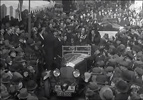 |
|
|
|
| |
 |
| |
"A brief Pathe News film clip with some nice shots of this car which can be found here.
This shows GO 1400 leading the parade at a Motor Week promotional event organised by the numerous motor traders in Great Portland Street in London's West End in 1933. The aviatrix Amy Johnson is sitting up on the back of the Bentley with the then Mayor of St Marylebone, John Fettes.
Above is a still from the Pathe News film of the 1933 Great Portland Street Motor Week parade showing MS 3926 leading with Amy Johnson and the local Mayor aboard. Another unidentified Bentley can be seen behind -- the Alvis Speed 20 tourer between them survives as a special in Germany." |
|
| |
|
|
| |
|
|
| |
Source:
Greg Wrapson (Historian - The Alvis Register) & Pathe News: Amy Johnson
Posted: Jul 09, 2019 |
|
| |
|
|
|
|
|
|
 |
| EARLIEST
RECORD OF HISTORICAL FACTS & INFORMATION |
 |
 |
| |
| Chassis No. |
MS3926 |
| Engine No. |
MS3929 |
| Registration
No. |
GO 1400 |
| Date of Delivery: |
Apr 1931 |
| Type of Body: |
4-seater |
| Coachbuilder: |
Vanden Plas |
| Type of Car: |
N  |
| |
|
| First Owner: |
MOORE T G |
|
|
| |
|
|
| |
More Info:
According to original Vanden Plas Coachbuilder
records, this car was originally fitted
with Body No. 1722 with a supercharged;
panelled Open Sports with fully balanced
wings; green; 3/1931.
Michael Hay, in his book Bentley:
The Vintage Years, 1997, states:
"D/7235. Vanden Plas body no. 1722.
Previously reg GMN 578 on lsle of Man." |
|
| |
|
|
| |
|
|
| |
Updated: Jul 06, 2007
Posted: Mar 01, 2007 |
|
| |
|
|
|
|
| |
| |
| |
| Submit
more information on this car |
| |
| |
| |
|
|
| |
| |
| |
 |
| |
| |
|
| |
|
 |
 |
 |
Sep 30, 2020 - Info and photograph received from Simon Hunt for Chassis No. RL3439 |
 |
 |
Sep 30, 2020 - Info and photographs received from Dick Clay for Chassis No. 147 |
 |
 |
Sep 29, 2020 - Info and photographs received from Ernst Jan Krudop for his Chassis No. AX1651 |
 |
 |
Sep 28, 2020 - Info and photographs received from Lars Hedborg
for his Chassis No. KL3590 |
 |
 |
Sep 25, 2020 - Info and photograph added for Registration No. XV 3207 |
 |
 |
Sep 24, 2020 - Info and photograph added for Registration No. YM 7165 |
 |
| [More] |
 |
|
|
|
 |
|
|
 |
 |
 |
|
CLUB TALK
Upcoming Vintage Bentley Events |
 |
|
|
 |
 |
 |
|
|
 |
| |
|